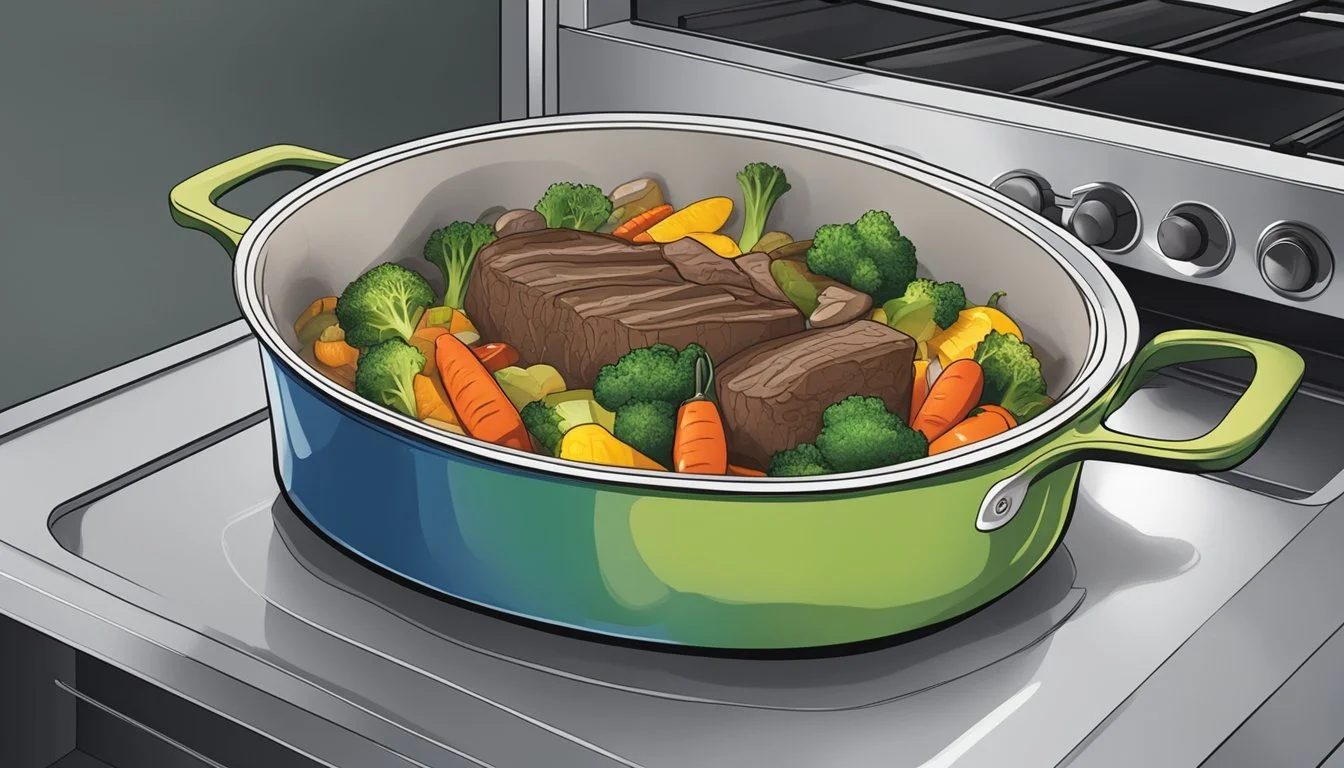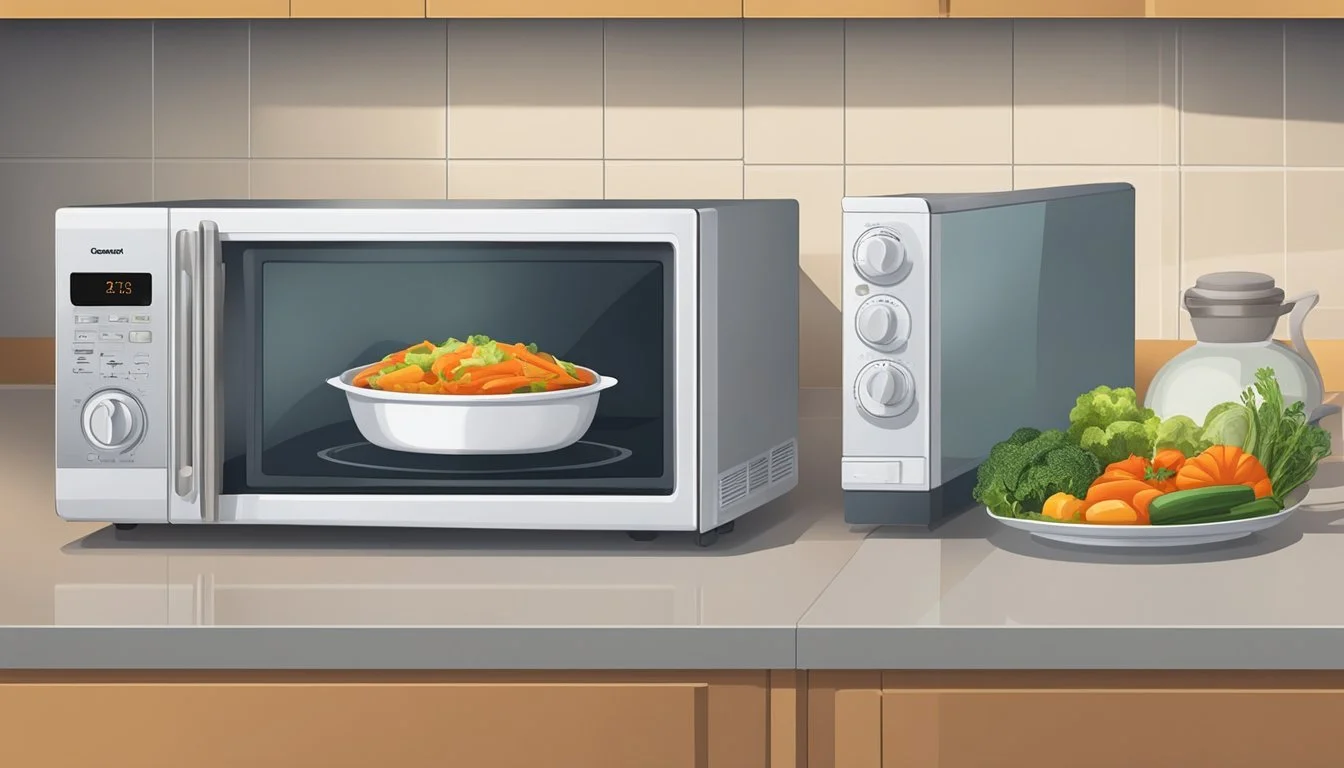How to Reheat Beef and Vegetable Casserole
Expert Tips for Perfect Results
Reheating a beef and vegetable casserole can be straightforward with the right approach. Using an oven is often the best method to ensure the casserole warms evenly and maintains its delicious flavor. Preheat the oven to 350 degrees Fahrenheit and cover the dish with aluminum foil to prevent it from drying out.
To retain the casserole's moisture, place a moist paper towel over the top before adding the foil. Heat for 20-30 minutes or until the internal temperature reaches 165 degrees Fahrenheit, ensuring it's safe to eat. This method not only heats the casserole thoroughly but also keeps it from becoming soggy or overly dry.
Taking the casserole out of the fridge 30 minutes before reheating helps it warm evenly. An instant-read thermometer is useful to check that the internal temperature is right. These steps make reheating a beef and vegetable casserole simple and effective.
Preparing Your Casserole for Reheating
Reheating beef and vegetable casserole requires different steps depending on whether it has been stored in the fridge or freezer. Using proper techniques ensures even heating and maintains moisture in the dish.
From the Fridge
Refrigerated casseroles should be taken out and allowed to sit at room temperature for about 20 minutes. This reduces the time needed to reheat. Preheat the oven to 350°F (175°C).
Cover the casserole with aluminum foil to retain moisture. Place the dish in the preheated oven and heat it for 20-30 minutes. Ensure the internal temperature reaches 165°F (74°C) using an instant-read thermometer.
For thicker casseroles, it might take longer. Check periodically to avoid drying out. Removing the foil for the last 5-10 minutes can help achieve a crispy top layer if desired.
From the Freezer
For frozen casseroles, it’s best to thaw them in the fridge overnight. If time is short, they can be defrosted in a microwave using the defrost setting.
Once thawed, let the casserole sit at room temperature for about 20 minutes. Preheat the oven to 350°F (175°C). Cover the dish with aluminum foil to prevent drying.
Place the casserole in the oven and bake for 30-40 minutes. Check that the center reaches 165°F (74°C). If it has not thawed completely, expect a longer reheating time.
Always ensure to cover the dish thoroughly as this helps in maintaining moisture and flavor throughout the reheating process.
Reheating Beef and Vegetable Casserole in the Oven
To reheat a beef and vegetable casserole in the oven effectively, it's essential to focus on setting the right temperature, covering the dish to prevent drying out, and ensuring the casserole is thoroughly heated.
Setting the Right Temperature
For best results, preheat the oven to 350 degrees Fahrenheit. This moderate temperature allows the casserole to heat evenly without overcooking any portions.
Preheating the oven ensures that the dish starts cooking at the right temperature immediately. Always use an oven-safe dish, as some materials may not withstand high heat. If the casserole has been refrigerated, consider taking it out 30-60 minutes before heating to reach room temperature, promoting more even reheating.
Covering to Prevent Drying Out
To retain moisture in the casserole, covering it properly is crucial. Use aluminum foil to cover the dish before placing it in the oven.
For extra moisture, place a damp paper towel over the casserole before covering with foil. This helps prevent the beef and vegetables from drying out during reheating. Ensuring a tight seal with the foil will keep the dish juicy and flavorful. If the casserole has a crispy topping, consider uncovering it in the last few minutes to maintain texture.
Checking for Doneness
Check the internal temperature of the casserole to ensure it reaches a safe level. The recommended temperature is 165 degrees Fahrenheit, which can be measured using an instant-read thermometer.
Insert the thermometer into the center of the casserole without touching the bottom of the dish. The reheating time generally ranges from 20-30 minutes, depending on the thickness and size of the casserole. Once this temperature is achieved, the casserole is ready to serve, ensuring both safety and optimal taste.
Using the Microwave for Reheating
Reheating a beef and vegetable casserole in a microwave can be quick and convenient. It requires careful attention to power levels and techniques to ensure even warming and maintain the casserole's texture.
Adjusting the Power Level
When using a microwave oven to reheat a beef and vegetable casserole, it is crucial to adjust the power level. Start by setting the microwave to 50% power. This lower power setting allows the casserole to warm evenly without overcooking the edges while the center remains cold.
Microwaves vary in strength, so it's essential to experiment with the time. For small portions, an initial duration of 2-3 minutes can be a good starting point. Larger portions may require incremental heating. Always monitor the casserole and stir midway to promote even heating. If the internal temperature is not yet 165°F, continue heating in 1-minute intervals.
Even Warming Techniques
To further ensure even warming, certain techniques can be employed. Place the casserole in a microwave-safe dish, spreading it out in an even layer. Cover the dish with a damp paper towel to retain moisture and prevent the casserole from drying out.
For best results, use the time-increment method. Set an initial timer for half of the estimated reheating time, stir the casserole, then continue in shorter intervals. This helps distribute the heat more evenly. Small portions benefit from these short bursts of heat combined with regular stirring. Always check that the internal temperature reaches 165°F to ensure safety.
Alternative Reheating Methods
For those seeking alternatives to the oven and microwave, the stovetop and appliances like air fryers or toaster ovens offer viable methods to reheat a beef and vegetable casserole effectively.
Using a Stovetop
Reheating a casserole on the stovetop can be quite effective. Begin by removing the casserole from the fridge and allowing it to come to room temperature for about 20 minutes.
Choose a large skillet or saucepan, designed to hold the quantity of food you are reheating, and add a small amount of water or broth to the pan to prevent the casserole from drying out. Place the skillet on the stovetop and heat it over medium-low heat.
Stir the casserole occasionally to ensure even heating. Cover the skillet with a lid to help trap steam and promote even heating. It generally takes around 10-15 minutes, depending on the quantity and initial temperature of the casserole, to heat it thoroughly. Using a food thermometer, ensure that the casserole reaches an internal temperature of 165°F to guarantee it is safe to eat.
Trying an Air Fryer or Toaster Oven
Air fryers and toaster ovens also offer convenient methods for reheating casseroles. Air fryers can provide a crispy texture to the top layer, which many find appealing. Preheat the air fryer to 350°F and place the casserole into the basket. Cook for approximately 10-15 minutes, checking periodically to prevent overcooking. Covering the casserole with foil can help retain moisture.
For a toaster oven, similar steps are followed. Preheat to 350°F and place the casserole in an oven-safe dish. Cover with aluminum foil to prevent drying out and heat for about 20-30 minutes. Make sure to check that the internal temperature reaches 165°F. Using the broiler setting for the last few minutes can add a nice browned, crispy top if desired.
Reheating Tips and Tricks
When reheating a beef and vegetable casserole, ensuring moisture retention and restoring the crispy topping greatly enhance the dish. Cover the casserole with foil and add a layer of cheese for optimal results.
Maintaining Moisture
To prevent moisture loss, follow these steps:
Cover with Foil: Covering the casserole with aluminum foil traps moisture. This keeps the dish from drying out during the reheating process.
Add Moisture: Adding a bit of extra sauce or broth before reheating can help maintain juiciness. Just a few tablespoons spread evenly can make a significant difference.
Low and Slow: Use a moderate temperature, around 350°F. This allows for even heating and helps avoid drying out. Check with an instant-read thermometer to ensure an internal temperature of 165°F.
Spray with Cooking Spray: Lightly spraying the casserole with cooking spray before covering can enhance moisture retention further.
Crispy Topping Restoration
To restore the crispy topping:
Initial Step: Reheat the casserole covered with foil to ensure the interior heats evenly without drying out.
Foil Removal: Remove the foil in the last 10-15 minutes of reheating. This allows the top layer to crisp up without overcooking the rest of the dish.
Use Fresh Cheese: Sprinkle additional cheese on top before uncovering. This gives a fresh, melted layer that can turn golden and crispy.
Broil Option: For an extra crispy finish, place the casserole under the broiler for a few minutes, watching closely to prevent burning.
By following these detailed tips and tricks, you can enjoy a deliciously warm and moist beef and vegetable casserole with a perfectly crispy topping.
Serving Your Reheated Casserole
Reheating your beef and vegetable casserole properly will ensure it's both delicious and safe to eat. Taking the right precautions and adding a few finishing touches can elevate your dish before serving.
Ensuring Food Safety
Before serving, it's crucial to confirm that the casserole has reached the safe temperature of 165°F. This ensures that any harmful bacteria are eliminated.
Using an instant-read thermometer, check the internal temperature of the casserole in multiple spots, especially in the center and the thickest parts. If the temperature is below 165°F, return it to the oven for a few more minutes and re-check.
Consistency in heating ensures even cooking, avoiding cold spots that could compromise food safety.
Final Touches before Serving
Adding the final touches enhances the presentation and flavor of your casserole. If the casserole was covered with foil during reheating, remove it for the last 5-10 minutes to allow the top to crisp up.
Garnish with fresh herbs like parsley or thyme for a burst of color and flavor.
Consider a light drizzle of extra virgin olive oil or a sprinkle of grated cheese to add richness and depth.
Serving the casserole immediately after reheating ensures it retains optimal texture and taste.
Using these tips will help you present a warm, flavorful dish that's safe and satisfying.
Storage and Food Safety
Storing a beef and vegetable casserole correctly extends its shelf life and ensures it remains safe to eat. Proper techniques and knowledge of when to discard leftovers are crucial for maintaining food safety.
Proper Casserole Storage
Casseroles should be stored in airtight containers to reduce exposure to air and prevent contamination. After cooking, allow the casserole to cool to room temperature before placing it in the refrigerator. Typically, casseroles can be kept refrigerated for up to 3-4 days.
For longer storage, consider freezing the casserole. It’s best to divide it into individual portions and place these in freezer-safe containers. When freezing, label containers with dates to track freshness. Ensure the casserole is fully reheated to an internal temperature of 165°F (74°C) to kill any potential bacteria.
Knowing When to Discard Leftovers
Pay attention to signs of spoilage such as unusual odors, discoloration, or a change in texture. Even if a casserole looks and smells fine, it should not be consumed if refrigerated more than 4 days or frozen for more than 2-3 months.
If any doubt exists about the safety of leftover casserole, it's safer to discard it rather than risk foodborne illness. Proper storage combined with timely consumption is key to safe leftovers.





